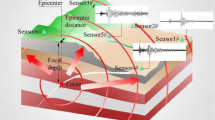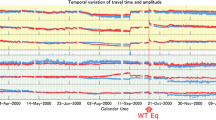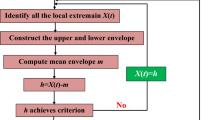Abstract
Although various types of geophones are applied in seismic exploration, there are only three common types of signals produced by geophones: displacement, velocity, and acceleration signals. Currently, our understanding of the signal characteristics, such as the generation mechanism, the geophysical properties, and the significance of the corresponding rock physics, remains unclear, which makes it difficult to both scientifically evaluate and take full advantage of the different types of geophones. In this paper, the mechanism by which seismic waves are generated is studied based on the spring-damped vibration theory. The physical characteristics of the three above-mentioned signal types and the relationships among the physical properties of the signals and medium are analyzed, as well as the signal-to-noise ratio (SNR), resolution, and spectrum characteristics. Based on laboratory tests, field experiments, and applications, we obtained the following conclusions. The acceleration signal reflects the elastic characteristics of the medium and the change rules, and the signal strength is positively correlated with physical property changes. The acceleration signal has favorable attributes, such as small distortion, high fidelity, strong high-frequency amplitudes, and a wide frequency band. Therefore, the acceleration signal is more suitable for high-precision seismic exploration of complex media. In addition, the P-wave acceleration signal more accurately reflects the elastic Young modulus, shear modulus, and density changes than the velocity signal. However, the sensitivity decreases with increasing shear modulus and density. For the S-wave, the acceleration signal is more sensitive to the shear modulus and density than the velocity signal.
Similar content being viewed by others
References
Bai, X. M., Yuan, S. H., Wang, Z. D., Chen, J. G., et al., Digital geophones and exploration of tight oil: 84th Ann. Internat. Mtg, Soc. Expl. Geophys., Expanded Abstracts, 254–258. https://doi.org/10.1190/segam2014-0406.1
Criss, J., 2016, Field experiments with digital sensors: The Leading Edge, 35, 586–588. https://doi.org/10.1190/tle35070586.1
Denis, M., Brem, V., Pradalie, F., Moinet, F., et al., 2013, Can land broadband seismic be as good as marine broadband: The Leading Edge, 32, 1382–1388. https://doi.org/10.1190/tle32111382.1
Dugan, J. P., DiMarco, R. L., and Martin, W. W., 1992, Low- frequency vibrational motion of arctic pack ice: Journal of Geophysical Research, 97, 5381–5388.
Havskov, J, and Alguacil, G., 2010, Instrumentation in earthquake seismology: 11–76, Springer.
He, Q. D., 1988, Seismic wave theory: 115–122, Geological Publishing House (in Chinese).
Hons, M., Stewart, R., Lawton, D., and Bertram, M., 2007, Ground motion through geophones and MEMS accelerometers: sensor comparison in theory, modeling and field 77th Ann. Internat. Mtg, Soc. Expl. Geophys., Expanded Abstracts, 11–15. https://doi.org/10.1190/1.2792372.
Hons, M., Stewart, R., Lawton, D., and Bertram, M, 2008, Field data comparisons of MEMS accelerometers and analog geophones: The Leading Edge, 27, 896–903, https://doi.org/10.1190/1.2954030.
Hornych, P., Simonin, J. M., Piau, J. M., and Cottineau, L. M., Gueguen, I. and Jacob, B., 2016, Evaluatio of weight in motion sensors on the IFSTTAR accelerated testing facility: The Roles of Accelerated Pavement Testing in Pavement Sustainability, 671–684, https://doi.org/10.1007/978-3-319-42797-3_44.
Lansley, M., Laurin, M., and Ronen, S., 2008, Modern land recording systems:How do they weigh up?: The Leading Edge, 27, 888–894. https://doi.org/10.1190/1.2954029
Liu, Z. D., Lu, Q. T., Dong, S. X., and Chen, M. C., 2012, Research on velocity and acceleration geophones and their acquired information: Applied Geophysics, 9, 149–158, https://doi.org/10.1007/s11770-012-0324-6.
Lv, G. H., 2005, Application of a new generation of geophone to improve seismic acquisition in onshore offshore transition areas: Applied Geophysics, 2, 235–240.
Mavko, G., Mukerji, T., and Dvorkin, J., 2003, The rock physics handbook:Tools for seismic analysis in porous media: Cambridge, 17–65.
Maxwell, P. W. and B. Cain, 1999, Field test of a micro-machined, electro-mechanical, digital seismic sensor: 69th Annual International Meeting, SEG, Expanded Abstracts, 621–624. https://doi.org/10.1190/1.1821099
Mougenot, D., 2004, How digital sensors compare to geophones?: 74th Annual International Meeting, SEG, Expanded Abstracts, 5–8. https://doi.org/10.1190/1.1842413
Sch Ön, J. H., 2004, Physical properties of rocks:Fundamentals and principles of petrophysics: Elsevier, 133–204.
Sheriff, R. E., and Geldart L. P., 1995, Exploration seismology (2nd ed.): Cambridge, 33–72.
Srinivasan, C., Willy, Y. A., and Gupta, I. D., 2010, Estimation of local magnitude of rockbursts using strong motion accelerograms in the mines of Kolar Gold Fields: Acta Geophysica, 58, 300–316, https://doi.org/10.2478/s11600-009-0022-9.
Stotter, C., and E., 2011, Evaluation of 3C microelectromechanical system data on a 2D line: Direct comparison with conventional vertical-component geophone arrays and PS-wave analysis: Geophysics, 76, 79–87. https://doi.org/10.1190/1.3561769.
Wang, J. Y., Hu, B. X., Li, W., Song, G. D., et al., 1016, Design and application of fiber Bragg grating (FBG) geophone for higher sensitivity and wider frequency range: Measurement, 79, 228–235.
Wei, J. D., 2013, Comparing the MEMS accelerometer and the analog geophone: The Leading Edge, 32, 1206–1210, https://doi.org/10.1190/tle32101206.1.
Acknowledgements
The authors thank Dr. Yu Cheng-Long for his help in rock physics research. The authors also thank Editor-in-Chief of Applied Geophysics Fan Wei-cui and the three reviewers for their valuable suggestions. The authors appreciate the support of “The key techniques for seismic exploration in marine carbonate areas” of the National Major Science and Technology Project of the “13th Five-year Plan”.
Author information
Authors and Affiliations
Corresponding author
Additional information
The research is supported by the National Major Science and Technology Project of “the 13th Five-year Plan” (No. 2017ZX05005004003).
Zhang Huai-Bang, seismic exploration senior engineer. graduated from China University of Petroleum in 2008 as a petroleum engineering major and subsequently received a Master of Geological Engineering from China University of Petroleum in 2010. He is currently a PhD candidate at the School of Geophysics of Chengdu University of Technology. He works at the Geophysical Institute of the Shengli Branch of the Sinopec Petroleum Engineering Geophysics Co., Ltd. His research interests include seismic acquisition, data processing, and urban geophysics.
Rights and permissions
About this article
Cite this article
Zhang, HB., Li, LM., Zhang, GD. et al. Seismic acceleration signal analysis and application. Appl. Geophys. 17, 67–80 (2020). https://doi.org/10.1007/s11770-020-0802-1
Received:
Revised:
Published:
Issue Date:
DOI: https://doi.org/10.1007/s11770-020-0802-1




